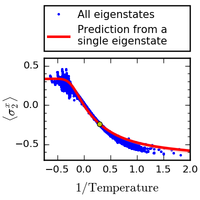Abstract
The eigenstate thermalization hypothesis (ETH) posits that the reduced density matrix for a subsystem corresponding to an excited eigenstate is “thermal.” Here we expound on this hypothesis by asking: For which class of operators, local or nonlocal, is ETH satisfied? We show that this question is directly related to a seemingly unrelated question: Is the Hamiltonian of a system encoded within a single eigenstate? We formulate a strong form of ETH where, in the thermodynamic limit, the reduced density matrix of a subsystem corresponding to a pure, finite energy density eigenstate asymptotically becomes equal to the thermal reduced density matrix, as long as the subsystem size is much less than the total system size, irrespective of how large the subsystem is compared to any intrinsic length scale of the system. This allows one to access the properties of the underlying Hamiltonian at arbitrary energy densities (or temperatures) using just a single eigenstate. We provide support for our conjecture by performing an exact diagonalization study of a nonintegrable 1D quantum lattice model with only energy conservation. In addition, we examine the case in which the subsystem size is a finite fraction of the total system size, and we find that, even in this case, many operators continue to match their canonical expectation values, at least approximately. In particular, the von Neumann entanglement entropy equals the thermal entropy as long as the subsystem is less than half the total system. Our results are consistent with the possibility that a single eigenstate correctly predicts the expectation values of all operators with support on less than half the total system, as long as one uses a microcanonical ensemble with vanishing energy width for comparison. We also study, both analytically and numerically, a particle-number conserving model at infinite temperature that substantiates our conjectures.
9 More- Received 31 August 2017
- Revised 14 December 2017
DOI:https://doi.org/10.1103/PhysRevX.8.021026
Published by the American Physical Society under the terms of the Creative Commons Attribution 3.0 License. Further distribution of this work must maintain attribution to the author(s) and the published article’s title, journal citation, and DOI.
Published by the American Physical Society
Physics Subject Headings (PhySH)
Popular Summary
For nearly a century, physicists have sought to better understand how certain isolated quantum systems eventually reach thermal equilibrium. This has become more relevant as experimentalists create nearly isolated systems using ultracold atoms. Systems that do equilibrate possess certain remarkable features in their stationary states—special states that do not evolve in time and are analogous to the harmonics of a musical instrument. One such feature is that many equilibrium properties are already apparent in these states. This motivates us to ask how much information a single stationary state encodes about the underlying system. We argue that, surprisingly, the knowledge of a single stationary state can provide access to properties of the system at all temperatures.
We demonstrate the aforementioned claim for a quantum spin system by calculating the exact stationary states and using a single state to make predictions for all temperatures. A crucial stepping-stone in our work is a new, fundamental observation about quantum chaos: Even nonlocal equilibrium properties of a system are encoded faithfully in its stationary states, as long as the system is sufficiently large in relation to its thermal correlation length.
Our results imply that one could study the low-temperature properties of a system without actually cooling the system down to that temperature. A researcher could prepare a system at a more practical temperature and then make nonlocal observations to deduce the behavior at low temperatures. The experimental technology for implementing this already exists; the main challenge would be studying large enough systems.



